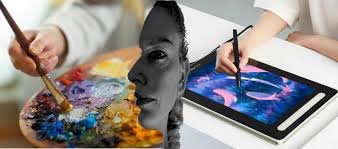Painting is a beautiful way to express creativity, but not all painting methods are the same. Paint By Numbers offers a simple, guided approach, while traditional painting lets you unleash your full artistic potential. Understanding the differences between these two can help you choose the right path for your artistic journey. Ever wondered why some artists stick to traditional techniques while others love the ease of Paint By Numbers? Let’s explore both methods to see what makes each one special.
What is Paint By Numbers?
Painting with Numbers is a method where a picture is divided into shapes. Each shape is marked with a number that corresponds to a specific color. You simply fill in the shapes with the matching colors, and a beautiful image emerges.
Paint By Numbers gained popularity in the 1950s. It was designed to make painting accessible to everyone, regardless of their skill level. Today, it’s a beloved hobby worldwide, known for its relaxing and rewarding nature.
What is Traditional Painting
Traditional painting involves creating art using various techniques and materials like oil, acrylic, and watercolor paints. Unlike Paint By Numbers, it allows complete freedom and creativity from the artist.
Traditional painting has a rich history dating back thousands of years. From ancient cave paintings to Renaissance masterpieces, it has evolved through many styles and periods. It remains a cornerstone of artistic expression.
Tools and Materials for Paint By Numbers and Traditional Painting
Choosing the right tools and materials is crucial for any painter. Both Paint By Numbers and traditional painting require specific supplies to bring your artwork to life. Let’s explore what each method needs.
Paint By Numbers
Kits:
Paint By Numbers kits include everything you need to start. Each kit typically contains a pre-printed canvas, numbered paint pots, and a set of brushes. The canvas is divided into sections, each marked with a number that matches a paint color.
Canvas:
The canvas in these kits is pre-outlined with the design. It’s usually made from durable materials like cotton or linen, ensuring longevity and ease of use.
Paints:
The paints provided are acrylic, known for their quick-drying properties. Each color is pre-mixed and labeled with a number corresponding to the sections on the canvas.
Brushes:
Kits often include multiple brushes of varying sizes. Smaller brushes are for detailed areas, while larger brushes cover bigger sections efficiently.
Traditional Painting
Canvas:
Traditional painters use different types of canvases. Choices range from cotton, linen, to canvas boards. Artists can also prime their canvases to suit specific techniques.
Paints:
Traditional painting offers a variety of paints, each with unique characteristics:
- Oil Paints: Known for their rich texture and slow drying time, allowing for detailed work and blending.
- Acrylic Paints: Versatile and fast-drying, suitable for various styles and surfaces.
- Watercolor Paints: Ideal for creating soft, transparent layers, often used on paper.
Types of Brushes:
A wide range of brushes is used in traditional painting. Brushes come in different shapes and sizes, including round, flat, filbert, and fan brushes. Each type serves a different purpose, from broad strokes to fine details.
Palettes:
Painters use palettes to mix their colors. Wooden or plastic palettes are common, providing a surface to blend and create new shades.
Traditional Painting Often Requires Additional Tools
- Easels: To hold the canvas upright.
- Palette Knives: For mixing colors or applying thick paint.
- Mediums: Such as linseed oil for oil paints, to alter the paint’s consistency and drying time.
- Varnishes: To protect finished paintings and enhance colors.

Understanding the tools and materials for each painting method helps you prepare better for your artistic journey.
Techniques and Processes
Understanding the techniques and processes behind Customized Paint By Numbers and traditional painting is essential for any artist. Each method has its unique steps and approaches. Let’s explore how these processes differ.
Paint By Numbers
- Preparation:
Before starting, set up your workspace. Lay out the canvas, paints, and brushes. Ensure good lighting and a clean surface to work on.
- Step-by-Step Process:
Paint By Numbers is a straightforward method. Each section of the canvas is marked with a number. This number corresponds to a specific paint color. You simply fill in the sections with the matching color. It’s like a puzzle, where each piece fits perfectly.
- Technique:
The technique involves careful application of paint within the lines. Start with larger areas and then move to smaller sections. Use small brushes for detailed areas. This method requires patience and attention to detail.
- Final Touches:
Once all sections are filled, review your work. Touch up any areas where the paint might be thin or uneven. Let the painting dry completely before displaying it.
Traditional Painting
Preparation:
Traditional painting begins with gathering materials. Prepare your canvas by priming it if necessary. Organize your brushes, paints, and other tools.
Sketching:
Start with a light sketch of your subject on the canvas. This serves as a guide for your painting. Use a pencil or a light wash of paint to create the outline.
Layering and Blending:
Traditional painting involves building layers. Begin with an underpainting to establish the basic shapes and tones. Gradually add more layers, working from general shapes to finer details. Blending colors is key. Use various brush techniques to create texture and depth.
Techniques:
There are many techniques in traditional painting:
- Glazing: Applying thin, transparent layers of paint to build up color and depth.
- Impasto: Using thick layers of paint to create texture.
- Scumbling: Applying a thin, opaque layer of paint to soften and blend colors. Each technique brings a different effect and feel to the painting.
Final Touches:
Finish with fine details using small brushes. Adjust lighting, shadows, and highlights to enhance the composition. Let the painting dry completely, then consider applying a varnish to protect it.
Both Paint By Numbers and traditional painting offer unique experiences and outcomes. Paint By Numbers provides a guided, relaxing process, perfect for beginners. Traditional painting offers creative freedom and depth, ideal for those looking to develop their skills. Understanding these techniques and processes helps you choose the best method for your artistic journey.
Benefits and Drawbacks
Choosing between Paint By Numbers and traditional painting involves understanding their benefits and drawbacks. Each method has unique advantages and challenges. Let’s explore both to see what fits your artistic needs best.

Paint By Numbers
There are many benefits of Paint by numbers including following:
- Beginner-Friendly:
Paint By Numbers is perfect for those new to painting. The pre-outlined canvas guides you, making it easy to start and finish a project without prior experience.
- Relaxing and Therapeutic:
The structured approach helps reduce stress. It’s a calming activity that many find therapeutic, offering a way to unwind and enjoy creativity without pressure.
- Quick and Satisfying Results:
You can complete a painting relatively quickly. This immediate gratification can boost confidence and encourage further artistic pursuits.
- Minimal Supplies Needed:
Kits include everything you need. You don’t have to buy separate supplies, which makes it a cost-effective option for beginners.
Drawbacks:
- Limited Creativity:
The structured nature limits personal expression. You follow the numbers and colors provided, which can restrict your creativity.
- Repetitive:
Filling in pre-determined sections can become monotonous. This lack of variation might not hold the interest of those looking for more artistic freedom.
- Quality of Materials:
Some kits may have lower-quality materials. This can affect the final outcome and your overall painting experience.
Traditional Painting
Benefits:
- Creative Freedom:
Traditional painting offers unlimited creative expression. You choose your subjects, colors, and techniques, allowing you to develop a unique artistic style.
- Skill Development:
Engaging in traditional painting helps develop various artistic skills. Techniques like blending, layering, and texturing enhance your overall artistry.
- Deep Connection:
Traditional painting creates a tactile and emotional connection with your work. The physical act of painting can be deeply satisfying and rewarding.
- Variety of Techniques:
You can explore numerous painting techniques. This variety keeps the process exciting and allows for continuous learning and growth.
Drawbacks:
- Learning Curve:
Traditional painting can be challenging for beginners. It requires time, patience, and practice to master different techniques and tools.
- More Supplies Needed:
You need various materials like brushes, paints, canvases, and mediums. This can be more expensive and requires careful selection and maintenance.
- Time-Consuming:
Creating a traditional painting can take a lot of time. This commitment might not suit everyone, especially those looking for quicker results.
Both Paint By Numbers and traditional painting offer unique experiences and outcomes. Paint By Numbers is ideal for beginners seeking a relaxing activity, while traditional painting is perfect for those looking to explore their creativity and develop their skills. Understanding these pros and cons can help you choose the method that best fits your artistic goals. Which approach will you try?
In short, both Paint By Numbers and traditional painting offer unique advantages. Paint By Numbers is great for beginners looking for a relaxing activity, while traditional painting lets you explore creativity and improve skills. Trying both can help you find what you enjoy most. Each method adds value to the art world, bringing joy and creativity to many. Dive into painting and discover what inspires you!












